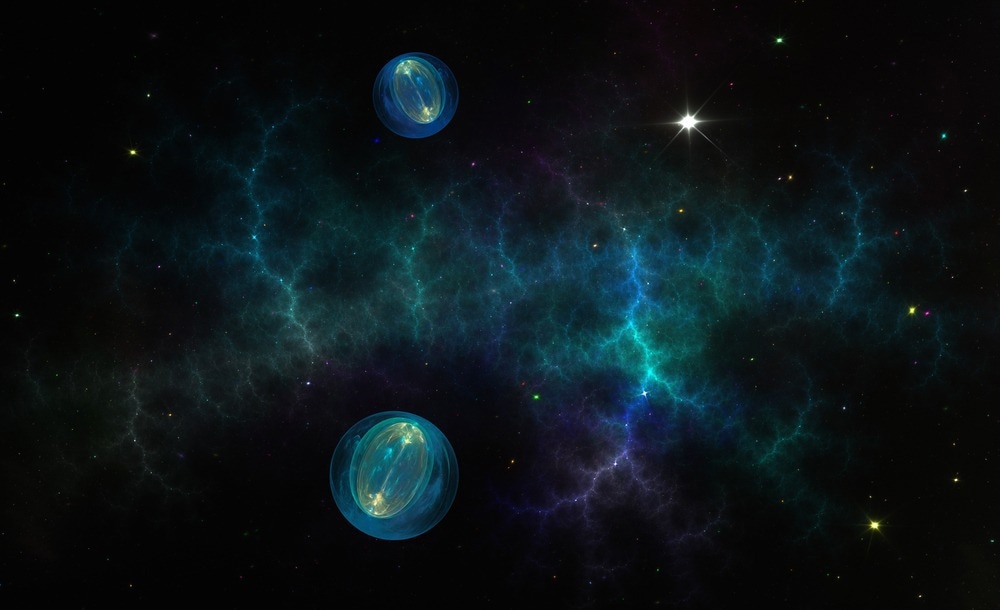The weakly interacting “ghost particles” were created in the Large Hadron Collider, the world’s most powerful particle accelerator.

Image Credit: kakteen/Shutterstock.com
Neutrinos are chargeless and virtually massless particles that interact with matter so weakly that 100 trillion of them pass through your body every second.
Unsurprisingly nick-named “ghost particles,” neutrinos are one of the most abundant fundamental particles in the universe, but because of their weak interactions are also among the toughest to actually detect.
As well as holding their own mysteries that must be solved, the study of neutrinos could also help scientists understand why there is anything in the universe at all. This is because these ghost particles are believed to be intrinsically tied to the process that led to matter dominating anti-matter in the early universe.
If the matter/anti-matter ratio had remained even, then these particles would have annihilated each other and left the universe as a vast cosmic desert filled with energy and no matter.
As part of the quest to understand neutrinos, physicists have been attempting to measure them when they are created by the collisions between particles at CERN’s Large Hadron Collider (LHC), the world’s most powerful particle accelerator.
Now, scientists led by researchers from the Laboratory for High Energy Physics (LHEP) at the University of Bern have finally detected neutrinos at the LHC for the first time. In fact, this is also the first time that researchers have measured neutrinos at any particle accelerator at all, despite particle collisions creating them in vast numbers.
The high-energy neutrinos were picked up by the Forward Search Experiment¹ (FASER) particle detector, with the team announcing their results at the MORIOND EW conference on electroweak interactions and unified theories held in La Thuile, Italy, on March 19.
Detecting Ghosts at the Large Hadron Collider
Discovered in 1956, the properties of neutrinos have been well-studied for the last seven decades or so. The difficulty in detecting these ghost particles has been offset by pioneering detectors that use vast vats of heavy water, chlorine, gallium, or even in one early detector, laundry detergent, in which one interaction between a neutrino and an atom sets off a fluorescent detector.
The University of Bern itself is one of the key players in the Deep Underground Neutrino Experiment (DUNE) currently being built in the U.S. Detectors like DUNE, which consists of two detectors, will be placed in the world’s most intense neutrino beam at Fermilab just outside Chicago and at the Sanford Underground Research Facility.
The highest energy particle accelerator available on Earth, the LHC, uses two beams of protons colliding together at relativistic speeds and, thus, high energies to generate a shower of secondary particles. These secondary particles should include neutrinos created in these collisions in huge numbers and at high energies. But until now, because of their weakly interacting nature, these particles have escaped the four main detectors at the LHC — ALICE, ATLAS, CMS, and LHCb.
To combat this, the FASER experiment was developed, capable of detecting light and extremely weakly interacting particles. The detector isn’t just designed to spot neutrinos but also other weakly interacting particles that might hint at physics beyond what is known as the standards model of particle physics, completed in 2012 at the LHC when scientists first detected the Higgs Boson.
Part of the FASER detector is the FASERν subdetector, made up of emulsion films and tungsten plates to act as both the target and the detector to see neutrino interactions.
Hidden in Plain Sight
To spot the first neutrinos from the LHC, the team of researchers looked at data generated at the LHC throughout 2022. Within this data, they spotted 153 events that can be labeled neutrino interactions with a high degree of certainty.
Among these events detected by FASER are the highest energy neutrinos produced by a source on Earth and detected by any experiment here on our planet. These neutrinos are such high energy that they resemble the neutrinos that pelt Earth from deep space.
This means that this breakthrough isn’t just important for particle physics, but it could help better understand cosmic neutrinos and the astrophysical sources that send them hurtling toward Earth.
Described by the researchers as a historic milestone for obtaining a new neutrino source with hitherto unexplored features, this detection is hopefully just the first of many. The FASER experiment will now continue to collect data until at least 2025, hunting for potentially hidden physics associated with these elusive and difficult-to-study particles.
More from AZoQuantum: Researchers Control Two Quantum Light Sources to Achieve Quantum Mechanical Entanglement
References and Further Reading
FASER, CERN, [Accessed 03/22/23], [https://home.cern/science/experiments/faser]
First detection of neutrinos made at a particle collider, University of Bern, [2023], [https://www.unibe.ch/news/media_news/media_relations_e/media_releases/2023/media_releases_2023/first_detection_of_neutrinos_made_at_a_particle_collider/index_eng.html]
Disclaimer: The views expressed here are those of the author expressed in their private capacity and do not necessarily represent the views of AZoM.com Limited T/A AZoNetwork the owner and operator of this website. This disclaimer forms part of the Terms and conditions of use of this website.